CHCECE007 TAFE NSW: Develop Positive and Respectful Relationships
VerifiedAdded on 2023/06/15
|41
|8388
|339
Homework Assignment
AI Summary
This assignment focuses on the CHCECE007 unit, which aims to equip students with the knowledge and skills to develop and maintain effective and respectful relationships with children. The assessment tasks cover various elements, including communicating positively, interacting respectfully, supporting children, and maintaining their dignity and rights. The assignment requires students to refer to textbooks, core documents like the Education and Care Services National Regulations, and additional readings on topics such as children's rights and positive behavior guidance. The tasks involve answering questions related to verbal and non-verbal communication strategies, positive interaction techniques, and responding to children's attempts to communicate. Additionally, the assignment includes scenarios that require students to apply their knowledge to real-world situations, such as creating a relaxed mealtime routine and engaging children in conversations. The overall goal is to ensure that students can create nurturing environments where children feel respected, supported, and encouraged to express themselves.
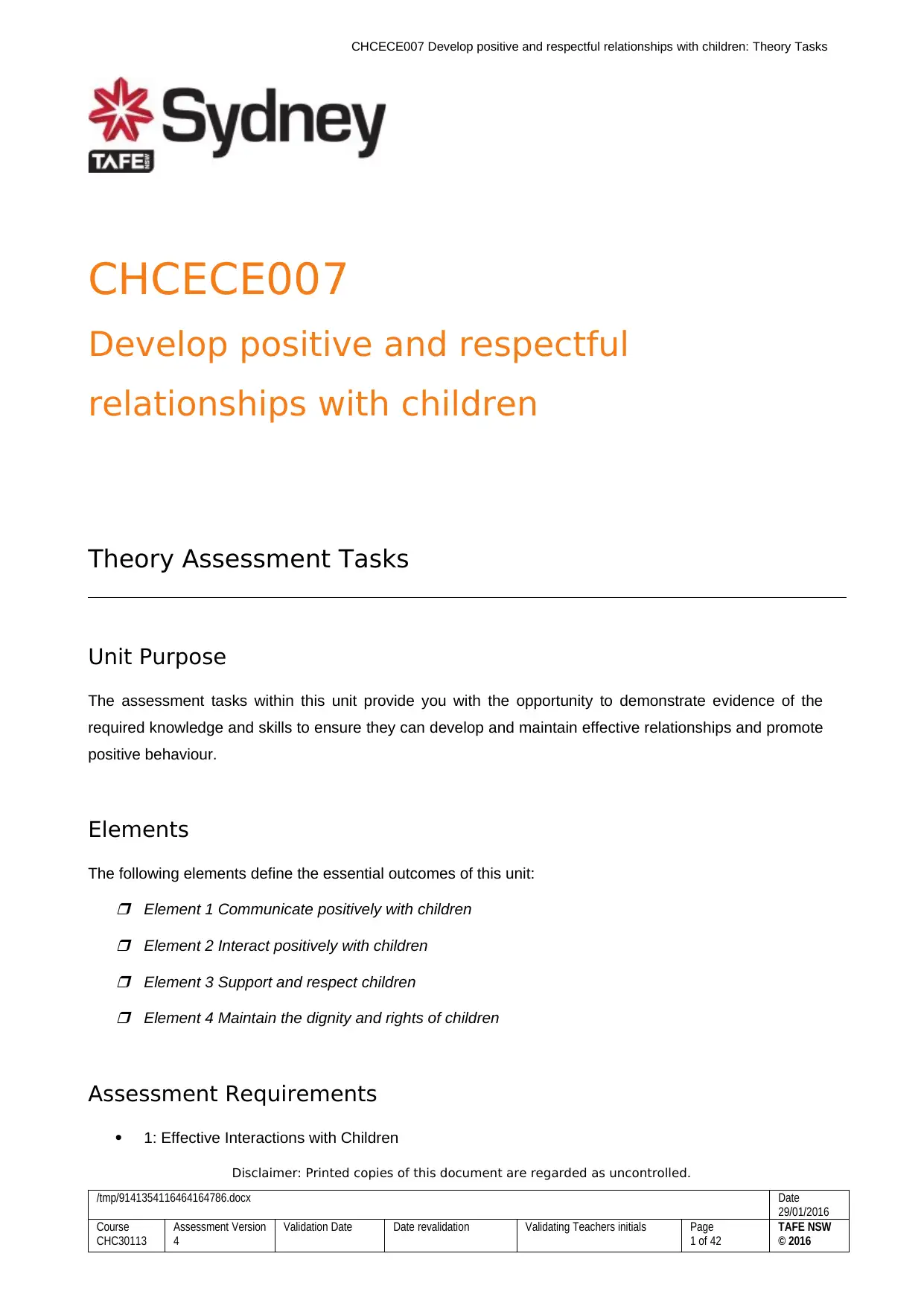
CHCECE007 Develop positive and respectful relationships with children: Theory Tasks
CHCECE007
Develop positive and respectful
relationships with children
Theory Assessment Tasks
Unit Purpose
The assessment tasks within this unit provide you with the opportunity to demonstrate evidence of the
required knowledge and skills to ensure they can develop and maintain effective relationships and promote
positive behaviour.
Elements
The following elements define the essential outcomes of this unit: Element 1 Communicate positively with children Element 2 Interact positively with children Element 3 Support and respect children Element 4 Maintain the dignity and rights of children
Assessment Requirements
1: Effective Interactions with Children
Disclaimer: Printed copies of this document are regarded as uncontrolled.
/tmp/9141354116464164786.docx Date
29/01/2016
Course
CHC30113
Assessment Version
4
Validation Date Date revalidation Validating Teachers initials Page
1 of 42
TAFE NSW
© 2016
CHCECE007
Develop positive and respectful
relationships with children
Theory Assessment Tasks
Unit Purpose
The assessment tasks within this unit provide you with the opportunity to demonstrate evidence of the
required knowledge and skills to ensure they can develop and maintain effective relationships and promote
positive behaviour.
Elements
The following elements define the essential outcomes of this unit: Element 1 Communicate positively with children Element 2 Interact positively with children Element 3 Support and respect children Element 4 Maintain the dignity and rights of children
Assessment Requirements
1: Effective Interactions with Children
Disclaimer: Printed copies of this document are regarded as uncontrolled.
/tmp/9141354116464164786.docx Date
29/01/2016
Course
CHC30113
Assessment Version
4
Validation Date Date revalidation Validating Teachers initials Page
1 of 42
TAFE NSW
© 2016
Paraphrase This Document
Need a fresh take? Get an instant paraphrase of this document with our AI Paraphraser
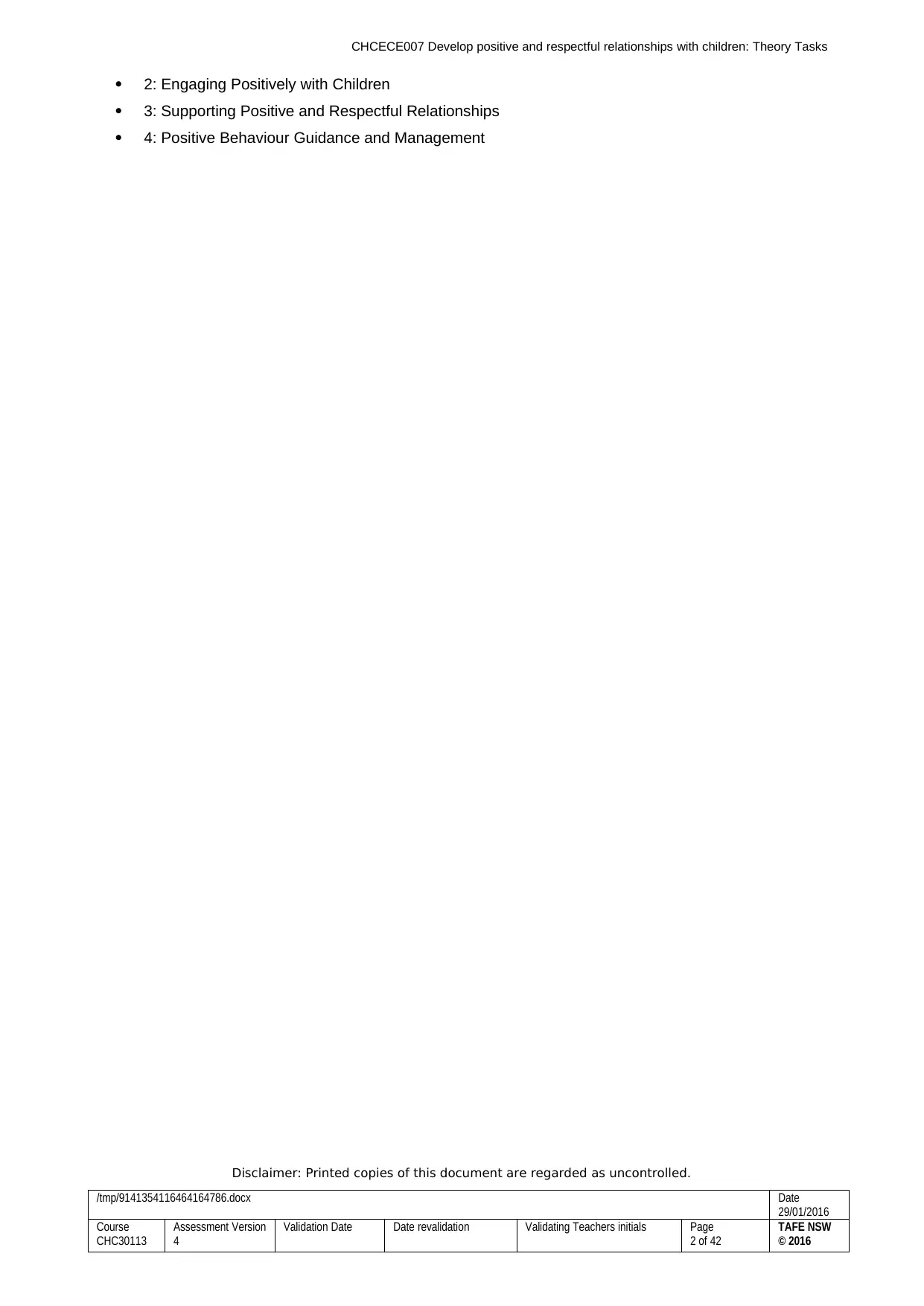
CHCECE007 Develop positive and respectful relationships with children: Theory Tasks
2: Engaging Positively with Children
3: Supporting Positive and Respectful Relationships
4: Positive Behaviour Guidance and Management
Disclaimer: Printed copies of this document are regarded as uncontrolled.
/tmp/9141354116464164786.docx Date
29/01/2016
Course
CHC30113
Assessment Version
4
Validation Date Date revalidation Validating Teachers initials Page
2 of 42
TAFE NSW
© 2016
2: Engaging Positively with Children
3: Supporting Positive and Respectful Relationships
4: Positive Behaviour Guidance and Management
Disclaimer: Printed copies of this document are regarded as uncontrolled.
/tmp/9141354116464164786.docx Date
29/01/2016
Course
CHC30113
Assessment Version
4
Validation Date Date revalidation Validating Teachers initials Page
2 of 42
TAFE NSW
© 2016
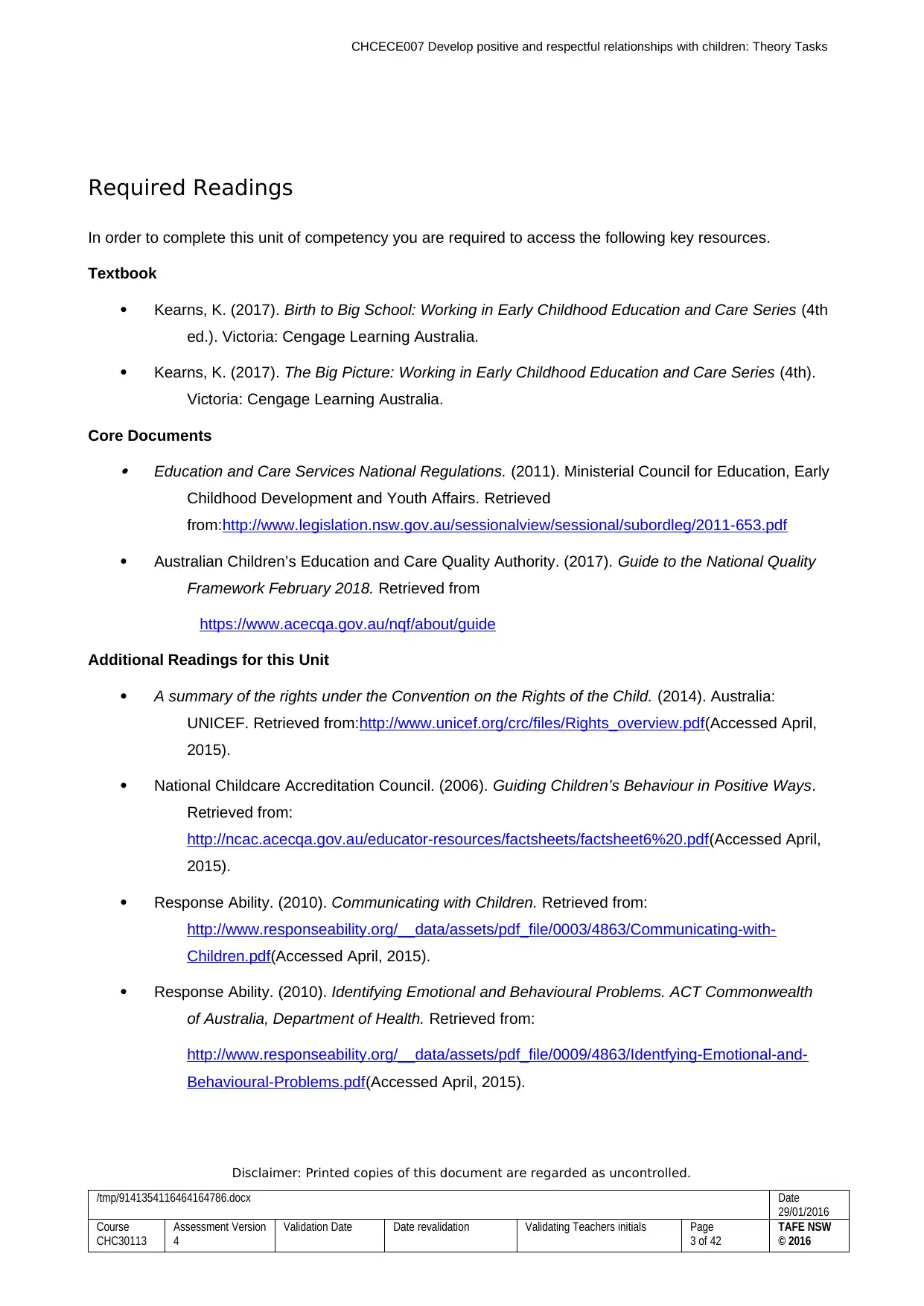
CHCECE007 Develop positive and respectful relationships with children: Theory Tasks
Required Readings
In order to complete this unit of competency you are required to access the following key resources.
Textbook
Kearns, K. (2017). Birth to Big School: Working in Early Childhood Education and Care Series (4th
ed.). Victoria: Cengage Learning Australia.
Kearns, K. (2017). The Big Picture: Working in Early Childhood Education and Care Series (4th).
Victoria: Cengage Learning Australia.
Core Documents Education and Care Services National Regulations. (2011). Ministerial Council for Education, Early
Childhood Development and Youth Affairs. Retrieved
from:http://www.legislation.nsw.gov.au/sessionalview/sessional/subordleg/2011-653.pdf
Australian Children’s Education and Care Quality Authority. (2017). Guide to the National Quality
Framework February 2018. Retrieved from
https://www.acecqa.gov.au/nqf/about/guide
Additional Readings for this Unit
A summary of the rights under the Convention on the Rights of the Child. (2014). Australia:
UNICEF. Retrieved from:http://www.unicef.org/crc/files/Rights_overview.pdf(Accessed April,
2015).
National Childcare Accreditation Council. (2006). Guiding Children’s Behaviour in Positive Ways.
Retrieved from:
http://ncac.acecqa.gov.au/educator-resources/factsheets/factsheet6%20.pdf(Accessed April,
2015).
Response Ability. (2010). Communicating with Children. Retrieved from:
http://www.responseability.org/__data/assets/pdf_file/0003/4863/Communicating-with-
Children.pdf(Accessed April, 2015).
Response Ability. (2010). Identifying Emotional and Behavioural Problems. ACT Commonwealth
of Australia, Department of Health. Retrieved from:
http://www.responseability.org/__data/assets/pdf_file/0009/4863/Identfying-Emotional-and-
Behavioural-Problems.pdf(Accessed April, 2015).
Disclaimer: Printed copies of this document are regarded as uncontrolled.
/tmp/9141354116464164786.docx Date
29/01/2016
Course
CHC30113
Assessment Version
4
Validation Date Date revalidation Validating Teachers initials Page
3 of 42
TAFE NSW
© 2016
Required Readings
In order to complete this unit of competency you are required to access the following key resources.
Textbook
Kearns, K. (2017). Birth to Big School: Working in Early Childhood Education and Care Series (4th
ed.). Victoria: Cengage Learning Australia.
Kearns, K. (2017). The Big Picture: Working in Early Childhood Education and Care Series (4th).
Victoria: Cengage Learning Australia.
Core Documents Education and Care Services National Regulations. (2011). Ministerial Council for Education, Early
Childhood Development and Youth Affairs. Retrieved
from:http://www.legislation.nsw.gov.au/sessionalview/sessional/subordleg/2011-653.pdf
Australian Children’s Education and Care Quality Authority. (2017). Guide to the National Quality
Framework February 2018. Retrieved from
https://www.acecqa.gov.au/nqf/about/guide
Additional Readings for this Unit
A summary of the rights under the Convention on the Rights of the Child. (2014). Australia:
UNICEF. Retrieved from:http://www.unicef.org/crc/files/Rights_overview.pdf(Accessed April,
2015).
National Childcare Accreditation Council. (2006). Guiding Children’s Behaviour in Positive Ways.
Retrieved from:
http://ncac.acecqa.gov.au/educator-resources/factsheets/factsheet6%20.pdf(Accessed April,
2015).
Response Ability. (2010). Communicating with Children. Retrieved from:
http://www.responseability.org/__data/assets/pdf_file/0003/4863/Communicating-with-
Children.pdf(Accessed April, 2015).
Response Ability. (2010). Identifying Emotional and Behavioural Problems. ACT Commonwealth
of Australia, Department of Health. Retrieved from:
http://www.responseability.org/__data/assets/pdf_file/0009/4863/Identfying-Emotional-and-
Behavioural-Problems.pdf(Accessed April, 2015).
Disclaimer: Printed copies of this document are regarded as uncontrolled.
/tmp/9141354116464164786.docx Date
29/01/2016
Course
CHC30113
Assessment Version
4
Validation Date Date revalidation Validating Teachers initials Page
3 of 42
TAFE NSW
© 2016
⊘ This is a preview!⊘
Do you want full access?
Subscribe today to unlock all pages.

Trusted by 1+ million students worldwide

CHCECE007 Develop positive and respectful relationships with children: Theory Tasks
Disclaimer: Printed copies of this document are regarded as uncontrolled.
/tmp/9141354116464164786.docx Date
29/01/2016
Course
CHC30113
Assessment Version
4
Validation Date Date revalidation Validating Teachers initials Page
4 of 42
TAFE NSW
© 2016
Disclaimer: Printed copies of this document are regarded as uncontrolled.
/tmp/9141354116464164786.docx Date
29/01/2016
Course
CHC30113
Assessment Version
4
Validation Date Date revalidation Validating Teachers initials Page
4 of 42
TAFE NSW
© 2016
Paraphrase This Document
Need a fresh take? Get an instant paraphrase of this document with our AI Paraphraser
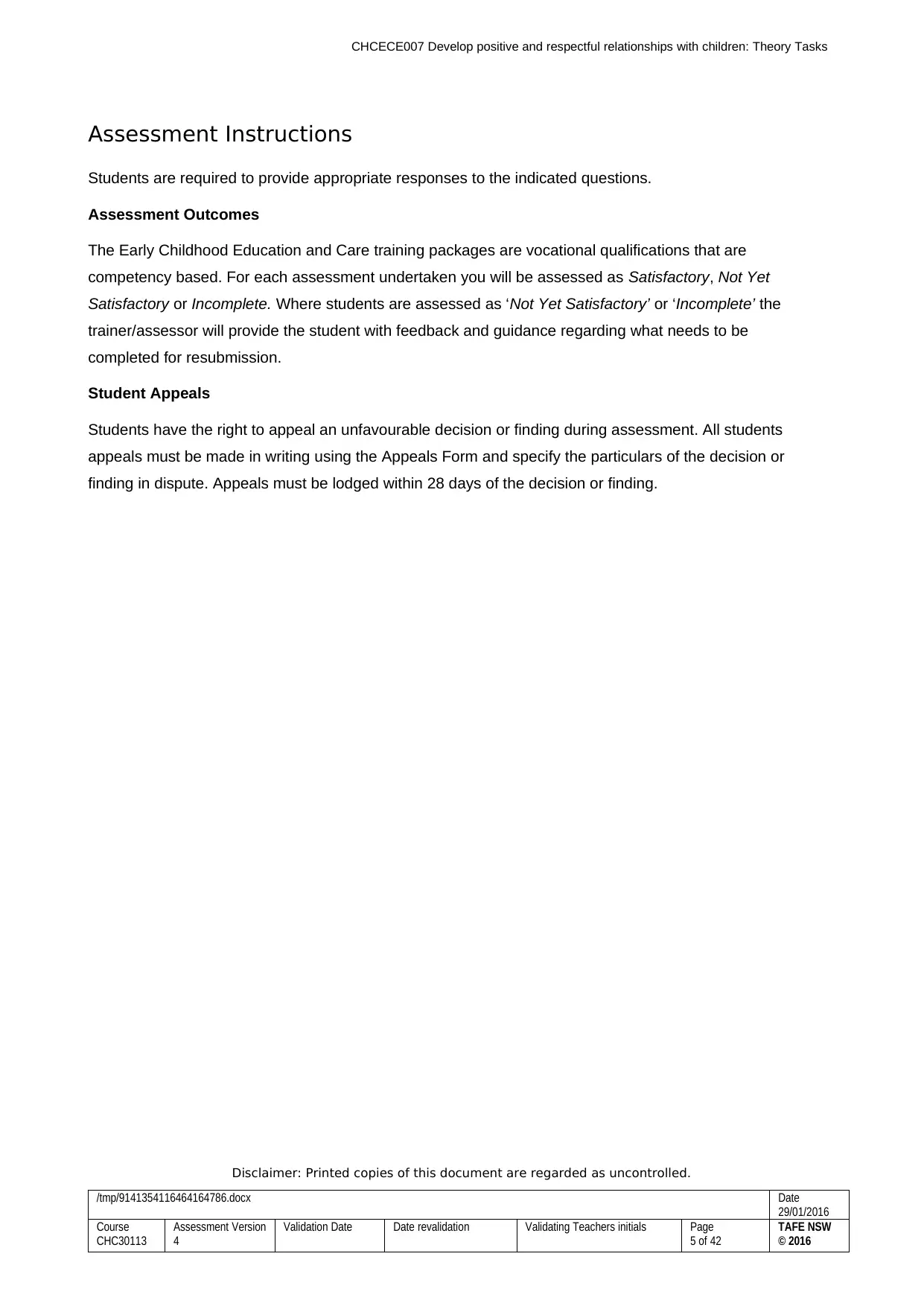
CHCECE007 Develop positive and respectful relationships with children: Theory Tasks
Assessment Instructions
Students are required to provide appropriate responses to the indicated questions.
Assessment Outcomes
The Early Childhood Education and Care training packages are vocational qualifications that are
competency based. For each assessment undertaken you will be assessed as Satisfactory, Not Yet
Satisfactory or Incomplete. Where students are assessed as ‘Not Yet Satisfactory’ or ‘Incomplete’ the
trainer/assessor will provide the student with feedback and guidance regarding what needs to be
completed for resubmission.
Student Appeals
Students have the right to appeal an unfavourable decision or finding during assessment. All students
appeals must be made in writing using the Appeals Form and specify the particulars of the decision or
finding in dispute. Appeals must be lodged within 28 days of the decision or finding.
Disclaimer: Printed copies of this document are regarded as uncontrolled.
/tmp/9141354116464164786.docx Date
29/01/2016
Course
CHC30113
Assessment Version
4
Validation Date Date revalidation Validating Teachers initials Page
5 of 42
TAFE NSW
© 2016
Assessment Instructions
Students are required to provide appropriate responses to the indicated questions.
Assessment Outcomes
The Early Childhood Education and Care training packages are vocational qualifications that are
competency based. For each assessment undertaken you will be assessed as Satisfactory, Not Yet
Satisfactory or Incomplete. Where students are assessed as ‘Not Yet Satisfactory’ or ‘Incomplete’ the
trainer/assessor will provide the student with feedback and guidance regarding what needs to be
completed for resubmission.
Student Appeals
Students have the right to appeal an unfavourable decision or finding during assessment. All students
appeals must be made in writing using the Appeals Form and specify the particulars of the decision or
finding in dispute. Appeals must be lodged within 28 days of the decision or finding.
Disclaimer: Printed copies of this document are regarded as uncontrolled.
/tmp/9141354116464164786.docx Date
29/01/2016
Course
CHC30113
Assessment Version
4
Validation Date Date revalidation Validating Teachers initials Page
5 of 42
TAFE NSW
© 2016
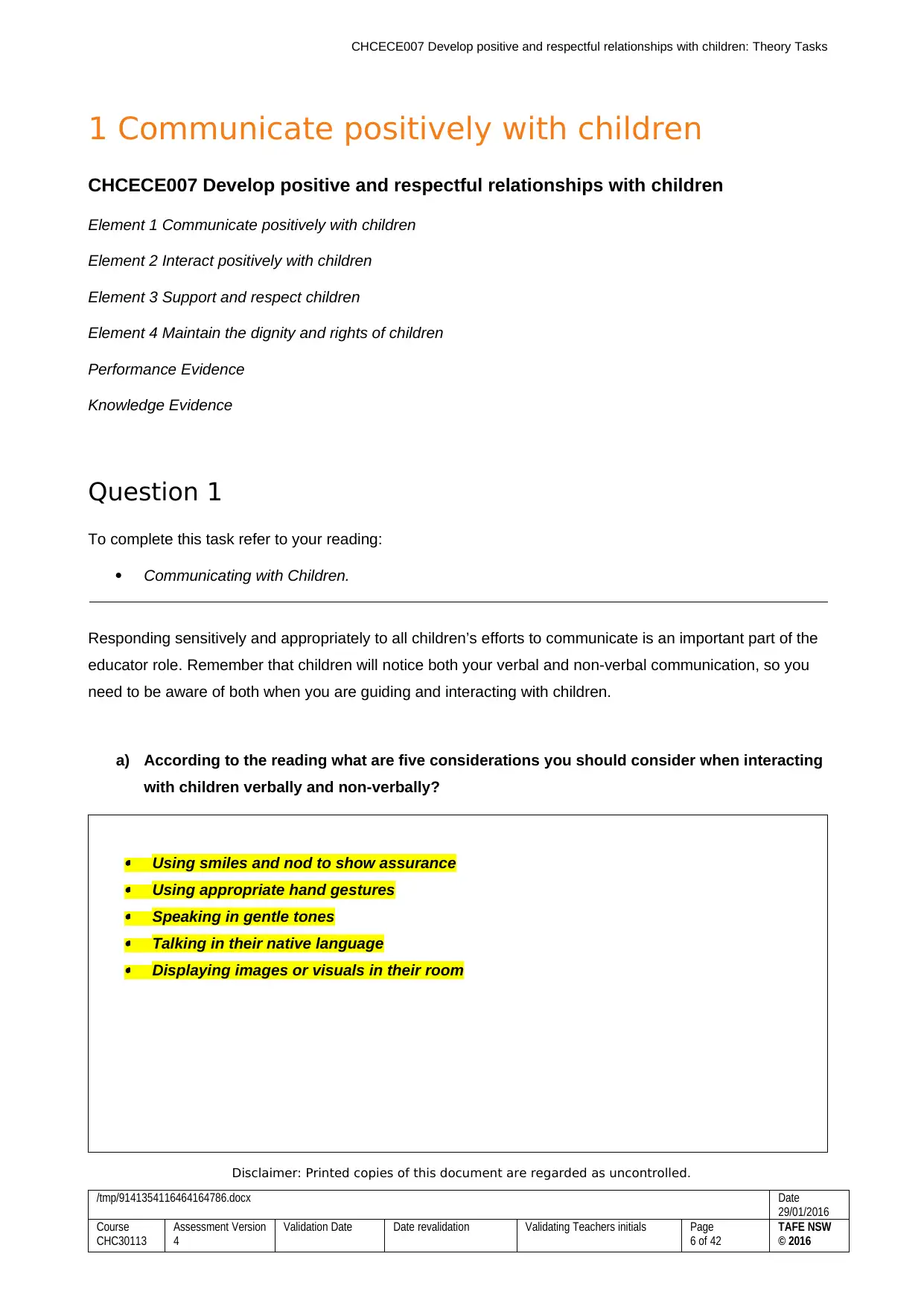
CHCECE007 Develop positive and respectful relationships with children: Theory Tasks
1 Communicate positively with children
CHCECE007 Develop positive and respectful relationships with children
Element 1 Communicate positively with children
Element 2 Interact positively with children
Element 3 Support and respect children
Element 4 Maintain the dignity and rights of children
Performance Evidence
Knowledge Evidence
Question 1
To complete this task refer to your reading:
Communicating with Children.
Responding sensitively and appropriately to all children’s efforts to communicate is an important part of the
educator role. Remember that children will notice both your verbal and non-verbal communication, so you
need to be aware of both when you are guiding and interacting with children.
a) According to the reading what are five considerations you should consider when interacting
with children verbally and non-verbally?
Using smiles and nod to show assurance Using appropriate hand gestures Speaking in gentle tones Talking in their native language Displaying images or visuals in their room
Disclaimer: Printed copies of this document are regarded as uncontrolled.
/tmp/9141354116464164786.docx Date
29/01/2016
Course
CHC30113
Assessment Version
4
Validation Date Date revalidation Validating Teachers initials Page
6 of 42
TAFE NSW
© 2016
1 Communicate positively with children
CHCECE007 Develop positive and respectful relationships with children
Element 1 Communicate positively with children
Element 2 Interact positively with children
Element 3 Support and respect children
Element 4 Maintain the dignity and rights of children
Performance Evidence
Knowledge Evidence
Question 1
To complete this task refer to your reading:
Communicating with Children.
Responding sensitively and appropriately to all children’s efforts to communicate is an important part of the
educator role. Remember that children will notice both your verbal and non-verbal communication, so you
need to be aware of both when you are guiding and interacting with children.
a) According to the reading what are five considerations you should consider when interacting
with children verbally and non-verbally?
Using smiles and nod to show assurance Using appropriate hand gestures Speaking in gentle tones Talking in their native language Displaying images or visuals in their room
Disclaimer: Printed copies of this document are regarded as uncontrolled.
/tmp/9141354116464164786.docx Date
29/01/2016
Course
CHC30113
Assessment Version
4
Validation Date Date revalidation Validating Teachers initials Page
6 of 42
TAFE NSW
© 2016
⊘ This is a preview!⊘
Do you want full access?
Subscribe today to unlock all pages.

Trusted by 1+ million students worldwide
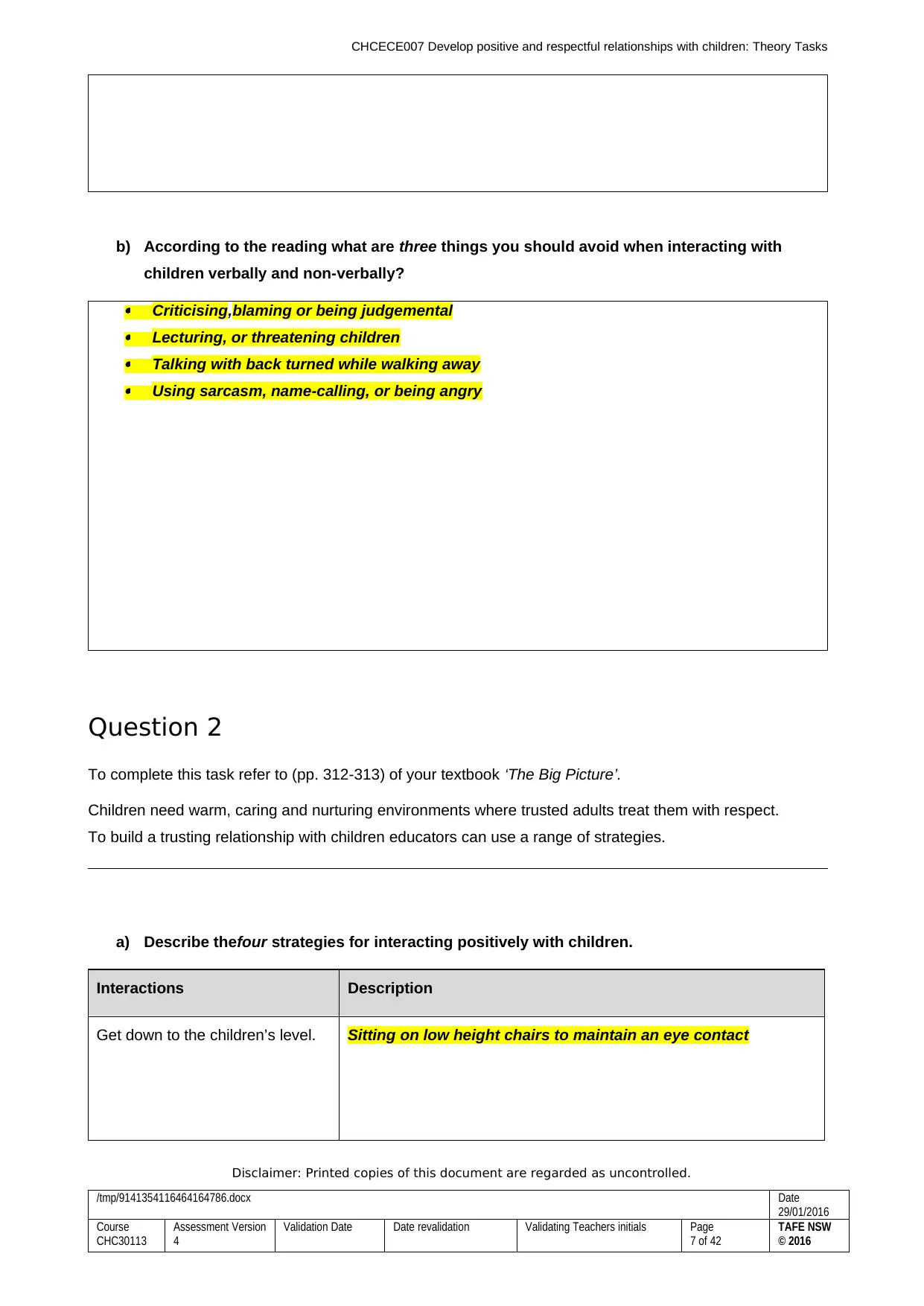
CHCECE007 Develop positive and respectful relationships with children: Theory Tasks
b) According to the reading what are three things you should avoid when interacting with
children verbally and non-verbally? Criticising,blaming or being judgemental Lecturing, or threatening children Talking with back turned while walking away Using sarcasm, name-calling, or being angry
Question 2
To complete this task refer to (pp. 312-313) of your textbook ‘The Big Picture’.
Children need warm, caring and nurturing environments where trusted adults treat them with respect.
To build a trusting relationship with children educators can use a range of strategies.
a) Describe thefour strategies for interacting positively with children.
Interactions Description
Get down to the children’s level. Sitting on low height chairs to maintain an eye contact
Disclaimer: Printed copies of this document are regarded as uncontrolled.
/tmp/9141354116464164786.docx Date
29/01/2016
Course
CHC30113
Assessment Version
4
Validation Date Date revalidation Validating Teachers initials Page
7 of 42
TAFE NSW
© 2016
b) According to the reading what are three things you should avoid when interacting with
children verbally and non-verbally? Criticising,blaming or being judgemental Lecturing, or threatening children Talking with back turned while walking away Using sarcasm, name-calling, or being angry
Question 2
To complete this task refer to (pp. 312-313) of your textbook ‘The Big Picture’.
Children need warm, caring and nurturing environments where trusted adults treat them with respect.
To build a trusting relationship with children educators can use a range of strategies.
a) Describe thefour strategies for interacting positively with children.
Interactions Description
Get down to the children’s level. Sitting on low height chairs to maintain an eye contact
Disclaimer: Printed copies of this document are regarded as uncontrolled.
/tmp/9141354116464164786.docx Date
29/01/2016
Course
CHC30113
Assessment Version
4
Validation Date Date revalidation Validating Teachers initials Page
7 of 42
TAFE NSW
© 2016
Paraphrase This Document
Need a fresh take? Get an instant paraphrase of this document with our AI Paraphraser
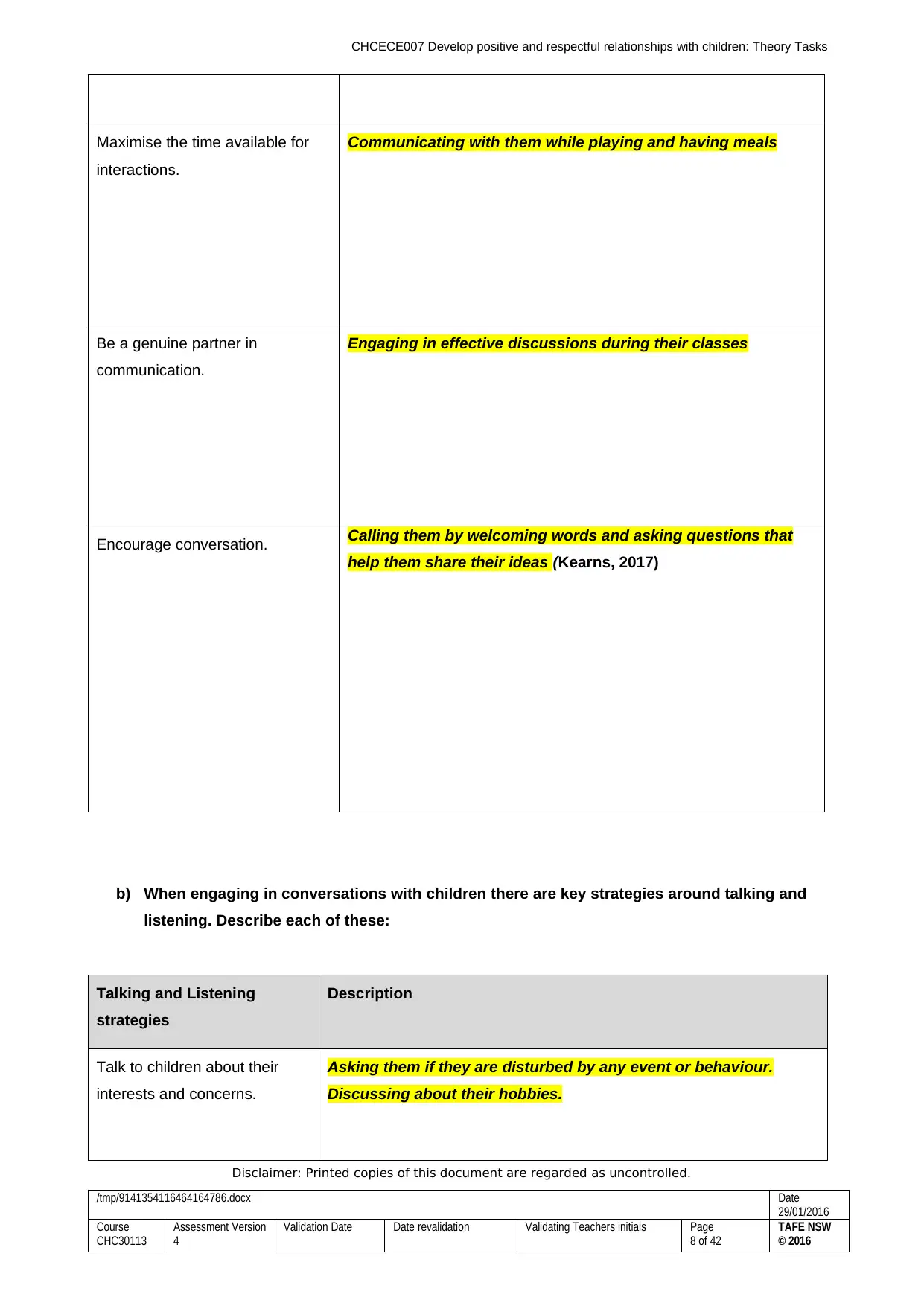
CHCECE007 Develop positive and respectful relationships with children: Theory Tasks
Maximise the time available for
interactions.
Communicating with them while playing and having meals
Be a genuine partner in
communication.
Engaging in effective discussions during their classes
Encourage conversation. Calling them by welcoming words and asking questions that
help them share their ideas (Kearns, 2017)
b) When engaging in conversations with children there are key strategies around talking and
listening. Describe each of these:
Talking and Listening
strategies
Description
Talk to children about their
interests and concerns.
Asking them if they are disturbed by any event or behaviour.
Discussing about their hobbies.
Disclaimer: Printed copies of this document are regarded as uncontrolled.
/tmp/9141354116464164786.docx Date
29/01/2016
Course
CHC30113
Assessment Version
4
Validation Date Date revalidation Validating Teachers initials Page
8 of 42
TAFE NSW
© 2016
Maximise the time available for
interactions.
Communicating with them while playing and having meals
Be a genuine partner in
communication.
Engaging in effective discussions during their classes
Encourage conversation. Calling them by welcoming words and asking questions that
help them share their ideas (Kearns, 2017)
b) When engaging in conversations with children there are key strategies around talking and
listening. Describe each of these:
Talking and Listening
strategies
Description
Talk to children about their
interests and concerns.
Asking them if they are disturbed by any event or behaviour.
Discussing about their hobbies.
Disclaimer: Printed copies of this document are regarded as uncontrolled.
/tmp/9141354116464164786.docx Date
29/01/2016
Course
CHC30113
Assessment Version
4
Validation Date Date revalidation Validating Teachers initials Page
8 of 42
TAFE NSW
© 2016

CHCECE007 Develop positive and respectful relationships with children: Theory Tasks
Be an attentive listener. Paying attention to what they say and showing immediate
responses
Talk to the child about their
family.
Asking them about the number of members in their house, their
parents, grandparents and others, and by what name does the
child call each one of them
Talk about yourself. Encouraging the child to tell his/her name, place of residence,
favourite colours, stories, cartoons and games
To complete this task refer to (pp. 336-337) of your textbook ‘Birth to Big School’.
Disclaimer: Printed copies of this document are regarded as uncontrolled.
/tmp/9141354116464164786.docx Date
29/01/2016
Course
CHC30113
Assessment Version
4
Validation Date Date revalidation Validating Teachers initials Page
9 of 42
TAFE NSW
© 2016
Be an attentive listener. Paying attention to what they say and showing immediate
responses
Talk to the child about their
family.
Asking them about the number of members in their house, their
parents, grandparents and others, and by what name does the
child call each one of them
Talk about yourself. Encouraging the child to tell his/her name, place of residence,
favourite colours, stories, cartoons and games
To complete this task refer to (pp. 336-337) of your textbook ‘Birth to Big School’.
Disclaimer: Printed copies of this document are regarded as uncontrolled.
/tmp/9141354116464164786.docx Date
29/01/2016
Course
CHC30113
Assessment Version
4
Validation Date Date revalidation Validating Teachers initials Page
9 of 42
TAFE NSW
© 2016
⊘ This is a preview!⊘
Do you want full access?
Subscribe today to unlock all pages.

Trusted by 1+ million students worldwide
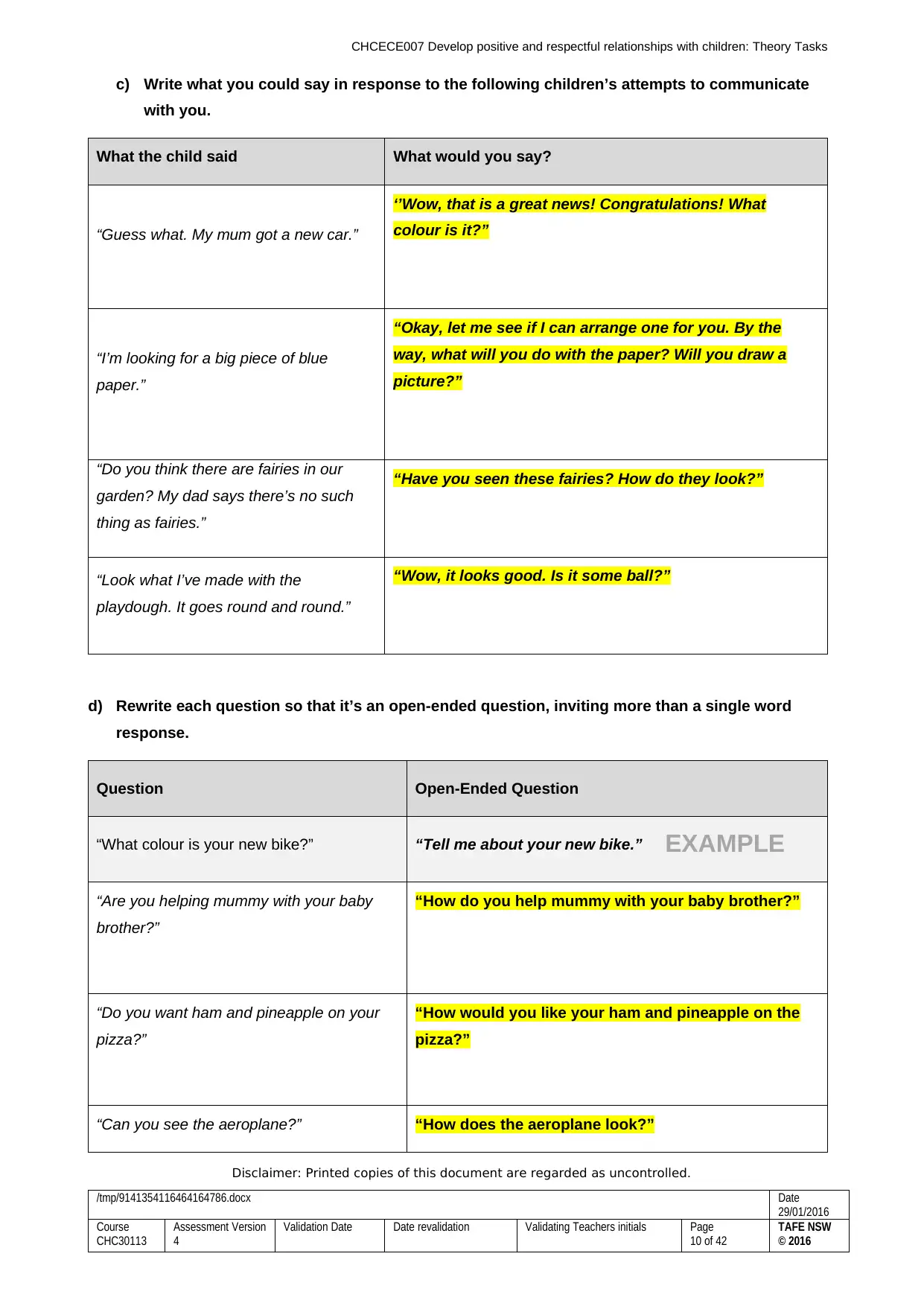
CHCECE007 Develop positive and respectful relationships with children: Theory Tasks
c) Write what you could say in response to the following children’s attempts to communicate
with you.
What the child said What would you say?
“Guess what. My mum got a new car.”
‘’Wow, that is a great news! Congratulations! What
colour is it?”
“I’m looking for a big piece of blue
paper.”
“Okay, let me see if I can arrange one for you. By the
way, what will you do with the paper? Will you draw a
picture?”
“Do you think there are fairies in our
garden? My dad says there’s no such
thing as fairies.”
“Have you seen these fairies? How do they look?”
“Look what I’ve made with the
playdough. It goes round and round.”
“Wow, it looks good. Is it some ball?”
d) Rewrite each question so that it’s an open-ended question, inviting more than a single word
response.
Question Open-Ended Question
“What colour is your new bike?” “Tell me about your new bike.”
“Are you helping mummy with your baby
brother?”
“How do you help mummy with your baby brother?”
“Do you want ham and pineapple on your
pizza?”
“How would you like your ham and pineapple on the
pizza?”
“Can you see the aeroplane?” “How does the aeroplane look?”
Disclaimer: Printed copies of this document are regarded as uncontrolled.
/tmp/9141354116464164786.docx Date
29/01/2016
Course
CHC30113
Assessment Version
4
Validation Date Date revalidation Validating Teachers initials Page
10 of 42
TAFE NSW
© 2016
EXAMPLE
c) Write what you could say in response to the following children’s attempts to communicate
with you.
What the child said What would you say?
“Guess what. My mum got a new car.”
‘’Wow, that is a great news! Congratulations! What
colour is it?”
“I’m looking for a big piece of blue
paper.”
“Okay, let me see if I can arrange one for you. By the
way, what will you do with the paper? Will you draw a
picture?”
“Do you think there are fairies in our
garden? My dad says there’s no such
thing as fairies.”
“Have you seen these fairies? How do they look?”
“Look what I’ve made with the
playdough. It goes round and round.”
“Wow, it looks good. Is it some ball?”
d) Rewrite each question so that it’s an open-ended question, inviting more than a single word
response.
Question Open-Ended Question
“What colour is your new bike?” “Tell me about your new bike.”
“Are you helping mummy with your baby
brother?”
“How do you help mummy with your baby brother?”
“Do you want ham and pineapple on your
pizza?”
“How would you like your ham and pineapple on the
pizza?”
“Can you see the aeroplane?” “How does the aeroplane look?”
Disclaimer: Printed copies of this document are regarded as uncontrolled.
/tmp/9141354116464164786.docx Date
29/01/2016
Course
CHC30113
Assessment Version
4
Validation Date Date revalidation Validating Teachers initials Page
10 of 42
TAFE NSW
© 2016
EXAMPLE
Paraphrase This Document
Need a fresh take? Get an instant paraphrase of this document with our AI Paraphraser
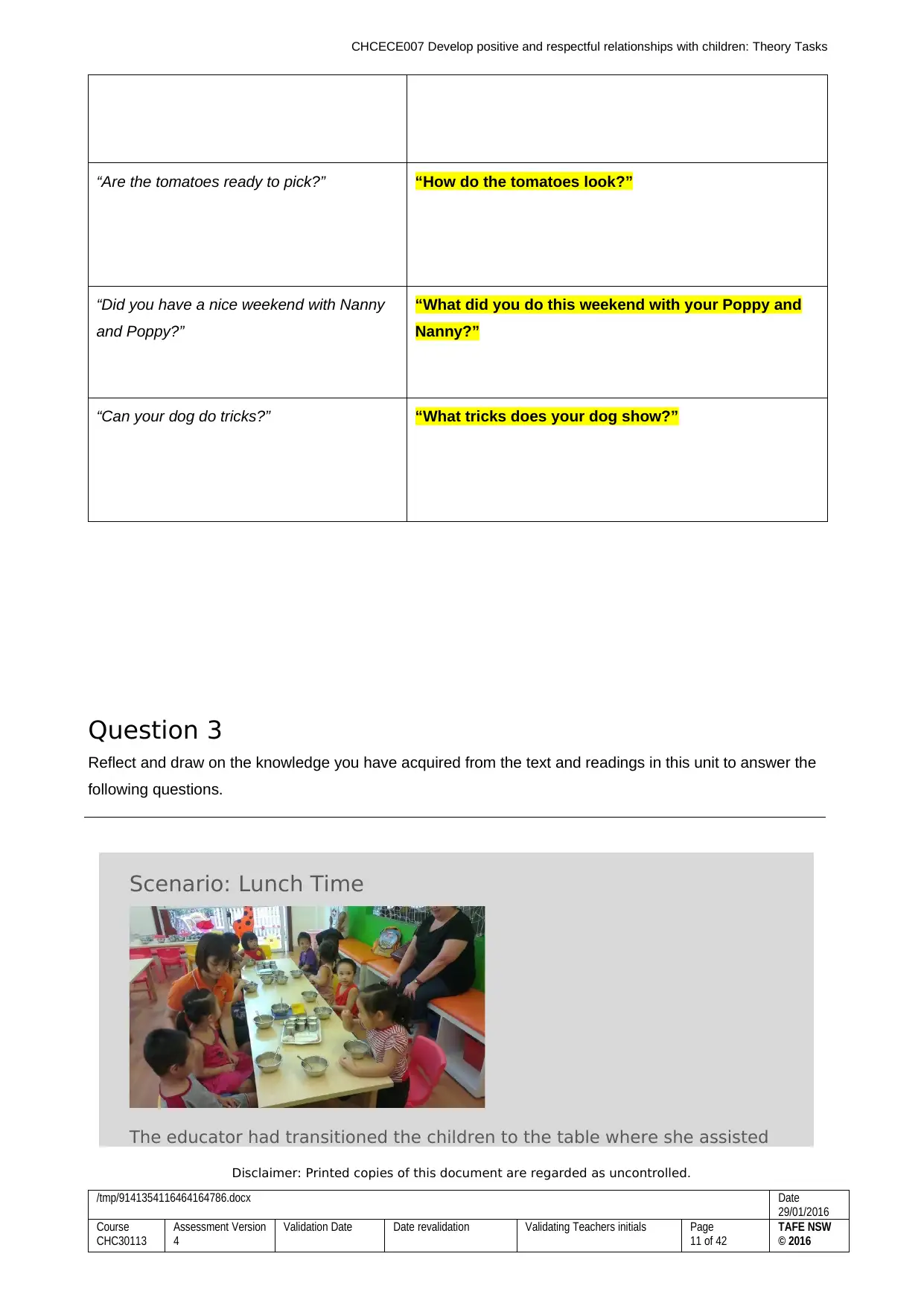
CHCECE007 Develop positive and respectful relationships with children: Theory Tasks
“Are the tomatoes ready to pick?” “How do the tomatoes look?”
“Did you have a nice weekend with Nanny
and Poppy?”
“What did you do this weekend with your Poppy and
Nanny?”
“Can your dog do tricks?” “What tricks does your dog show?”
Question 3
Reflect and draw on the knowledge you have acquired from the text and readings in this unit to answer the
following questions.
Scenario: Lunch Time
The educator had transitioned the children to the table where she assisted
Disclaimer: Printed copies of this document are regarded as uncontrolled.
/tmp/9141354116464164786.docx Date
29/01/2016
Course
CHC30113
Assessment Version
4
Validation Date Date revalidation Validating Teachers initials Page
11 of 42
TAFE NSW
© 2016
“Are the tomatoes ready to pick?” “How do the tomatoes look?”
“Did you have a nice weekend with Nanny
and Poppy?”
“What did you do this weekend with your Poppy and
Nanny?”
“Can your dog do tricks?” “What tricks does your dog show?”
Question 3
Reflect and draw on the knowledge you have acquired from the text and readings in this unit to answer the
following questions.
Scenario: Lunch Time
The educator had transitioned the children to the table where she assisted
Disclaimer: Printed copies of this document are regarded as uncontrolled.
/tmp/9141354116464164786.docx Date
29/01/2016
Course
CHC30113
Assessment Version
4
Validation Date Date revalidation Validating Teachers initials Page
11 of 42
TAFE NSW
© 2016
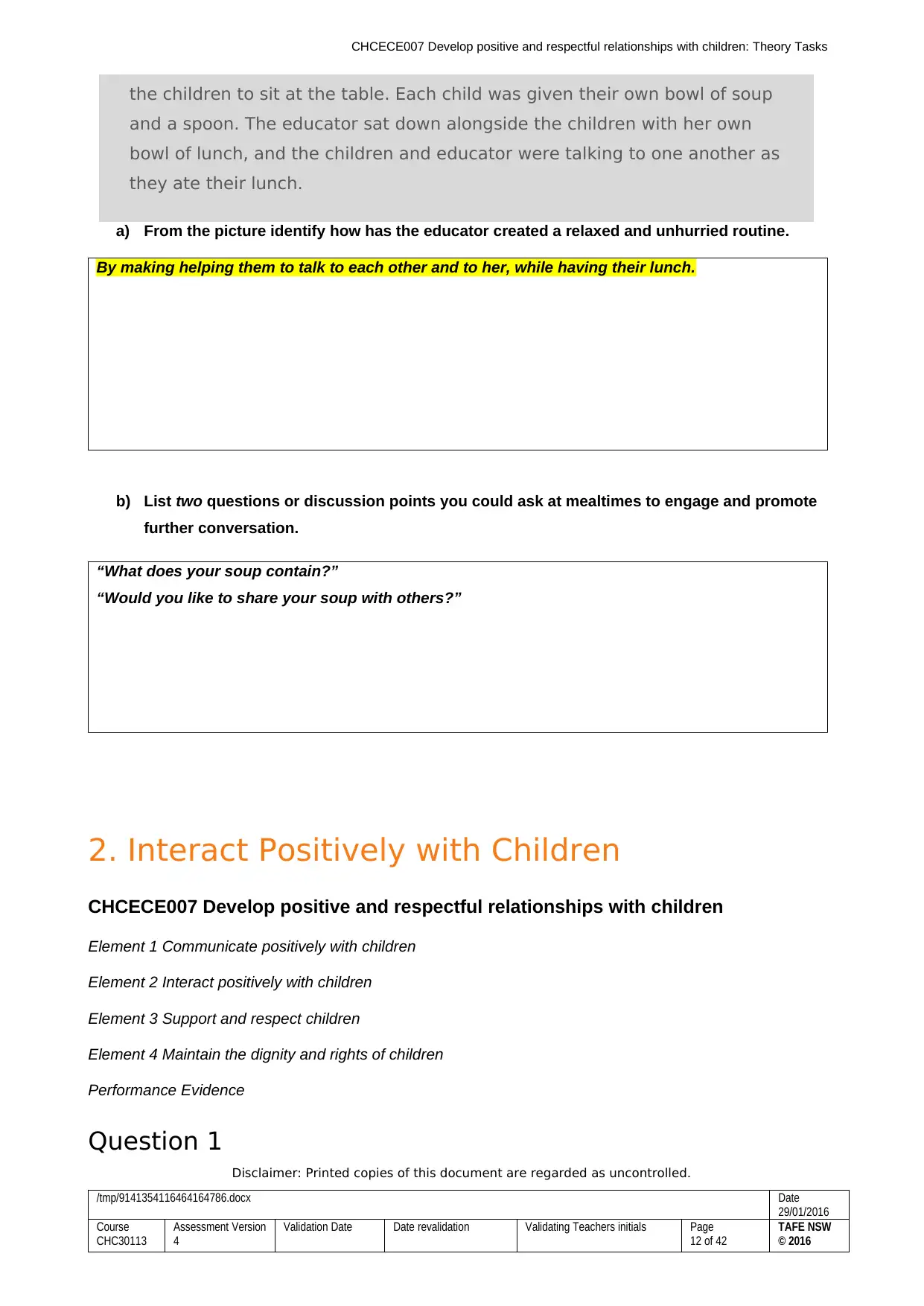
CHCECE007 Develop positive and respectful relationships with children: Theory Tasks
the children to sit at the table. Each child was given their own bowl of soup
and a spoon. The educator sat down alongside the children with her own
bowl of lunch, and the children and educator were talking to one another as
they ate their lunch.
a) From the picture identify how has the educator created a relaxed and unhurried routine.
By making helping them to talk to each other and to her, while having their lunch.
b) List two questions or discussion points you could ask at mealtimes to engage and promote
further conversation.
“What does your soup contain?”
“Would you like to share your soup with others?”
2. Interact Positively with Children
CHCECE007 Develop positive and respectful relationships with children
Element 1 Communicate positively with children
Element 2 Interact positively with children
Element 3 Support and respect children
Element 4 Maintain the dignity and rights of children
Performance Evidence
Question 1
Disclaimer: Printed copies of this document are regarded as uncontrolled.
/tmp/9141354116464164786.docx Date
29/01/2016
Course
CHC30113
Assessment Version
4
Validation Date Date revalidation Validating Teachers initials Page
12 of 42
TAFE NSW
© 2016
the children to sit at the table. Each child was given their own bowl of soup
and a spoon. The educator sat down alongside the children with her own
bowl of lunch, and the children and educator were talking to one another as
they ate their lunch.
a) From the picture identify how has the educator created a relaxed and unhurried routine.
By making helping them to talk to each other and to her, while having their lunch.
b) List two questions or discussion points you could ask at mealtimes to engage and promote
further conversation.
“What does your soup contain?”
“Would you like to share your soup with others?”
2. Interact Positively with Children
CHCECE007 Develop positive and respectful relationships with children
Element 1 Communicate positively with children
Element 2 Interact positively with children
Element 3 Support and respect children
Element 4 Maintain the dignity and rights of children
Performance Evidence
Question 1
Disclaimer: Printed copies of this document are regarded as uncontrolled.
/tmp/9141354116464164786.docx Date
29/01/2016
Course
CHC30113
Assessment Version
4
Validation Date Date revalidation Validating Teachers initials Page
12 of 42
TAFE NSW
© 2016
⊘ This is a preview!⊘
Do you want full access?
Subscribe today to unlock all pages.

Trusted by 1+ million students worldwide
1 out of 41
Related Documents
Your All-in-One AI-Powered Toolkit for Academic Success.
+13062052269
info@desklib.com
Available 24*7 on WhatsApp / Email
![[object Object]](/_next/static/media/star-bottom.7253800d.svg)
Unlock your academic potential
Copyright © 2020–2025 A2Z Services. All Rights Reserved. Developed and managed by ZUCOL.


